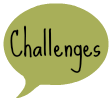I'll explain using an irregular pattern that all English speakers are aware of. To make a noun plural in English, 99% of the time we add -s or -es; cat --> cats, ash --> ashes. But in a very small number of cases, we change the vowel of the noun instead. I think these are all of them:
- mouse --> mice
- louse --> lice
- man --> men
- woman --> women
- tooth --> teeth
- goose --> geese
- foot --> feet
- (brother --> brethren)
But where did these irregular plurals come from? Here's where it gets slightly complicated, so bear with me. We have to think a little bit about how people talk. When you say a word, you don't make each individual sound separately; they kind of blend together. That is, while you're making one sound, your tongue is already preparing to make the next one.
For example, try saying the words "cool" and "key" one after the other. Pay attention to where your tongue is during the k sound in each word. Can you feel a difference? You should notice that the back of your tongue is hitting the roof of your mouth further forward in "key" than in "cool". This is because your tongue is getting ready to make the "ee" sound, which is further forward than the "oo" sound.
This phenomenon is called coarticulation. It allows us to speak at a pretty fast rate. The cool thing is, we've evolved to be able to understand speech even with all this blending together of sounds--we can actually (usually) undo the effects of coarticulation in our brains while we're listening to someone talk.
OK, so what does this have to do with irregular plurals? Well, back in many of the early Germanic languages, around 500 A.D., there was apparently a whole lot of coarticulation between vowels in adjacent syllables--so much that it became an active part of the languages' pronunciation. In particular, the "ee" sound really messed with the vowel that came before it. For example:
- the pre-English word for "mouse" was mūs (pronounced "moose"), and its plural was mūsi
- in very early English, the u in mūsi had been warped by the following i into a sound spelled with y. This sound is like an "ee" sound made with rounded lips (like ü in German or y in French)
- so the word mūs now had the plural mȳsi
At first, the vowel changes were completely regular and predictable--they happened any time an i followed. But here's the critical part: at some point, the i's stopped being pronounced. So now English had these singular/plural pairs:
- mūs --> mȳs
- fōt --> fø̄t
Now, since the reason for the vowel change was no longer there, people simply had to start memorizing these weird plural forms. Most of them ended up vanishing over time due to analogy with regular plural forms; for example, the plural for book should be beek! Only a tiny number have managed to hang on to the present day. Mȳs became mīs (pronounced "meese") and fø̄t became fēt (pronounced "fate") in Early Middle English, and then around Chaucer's time they got their modern pronunciations mice and feet.
There are many other remnants of umlaut left in other parts of English: old --> elder, strong --> strength, food --> feed, fox --> vixen; but in all cases the original cause of the vowel change is gone, and the words must simply be memorized by learners.
So to go back to our initial question: where does irregularity come from? It usually seems to start out as regularity, and only becomes irregular as a result of totally unrelated changes (in this case, the loss of i). So there's really no way to prevent it from arising. Sorry, all of you trying to learn a new language--irregularity is here to stay!
*Incidentally, for many people mouses is the plural form of mouse as in "the device used to move the cursor on a computer screen". This shows us that these people have two separate "mouse" entries in their mental dictionaries: one (referring to a small mammal) with an irregular plural, and another with a regular one.








No comments:
Post a Comment